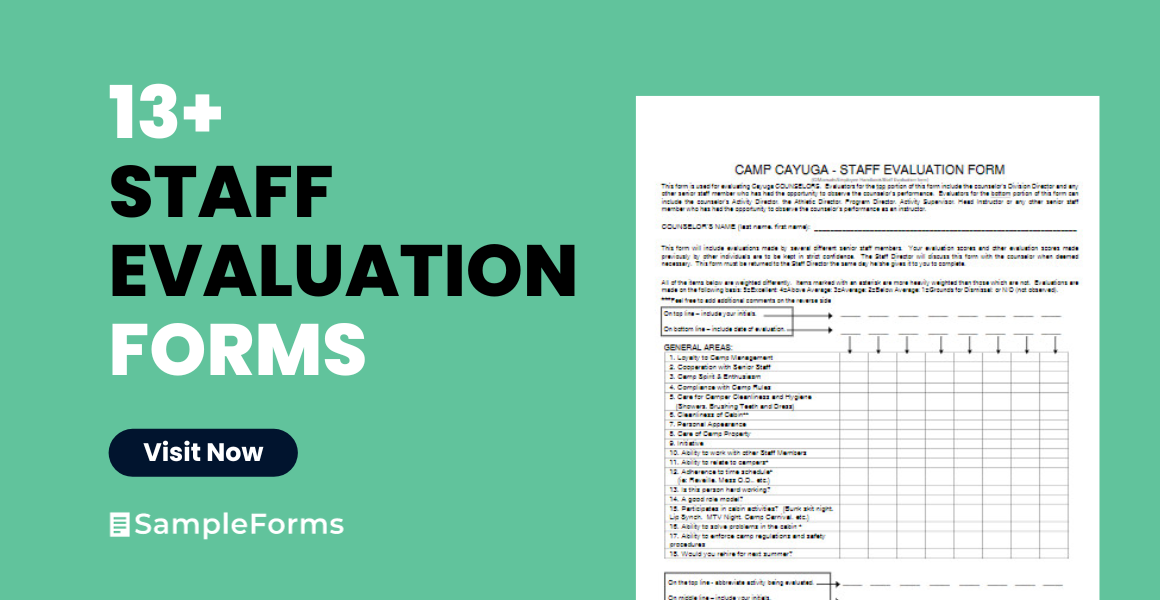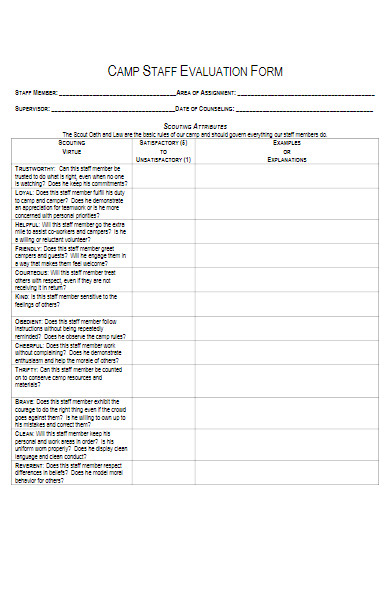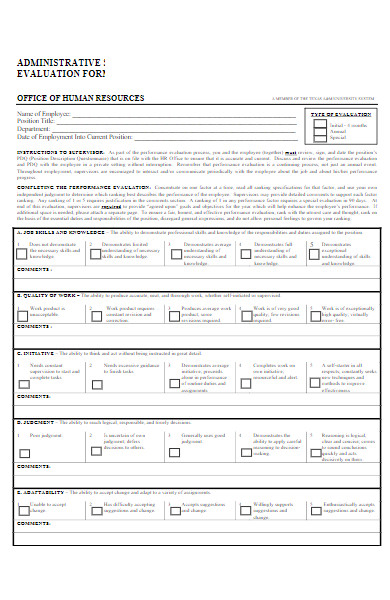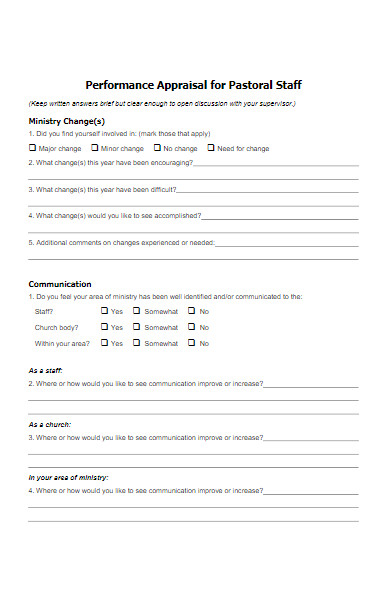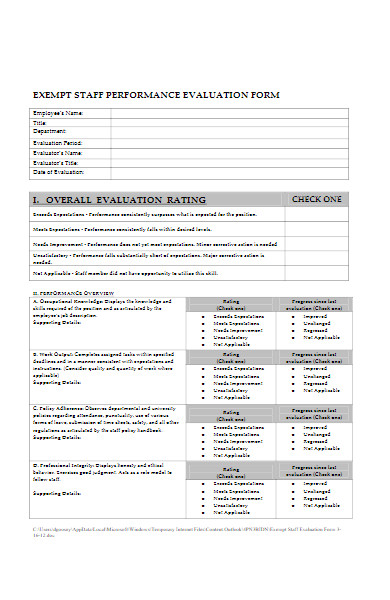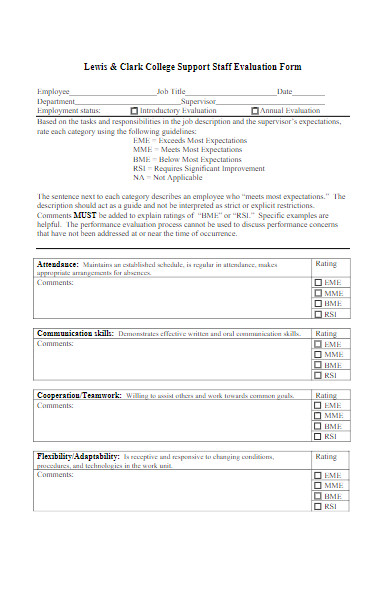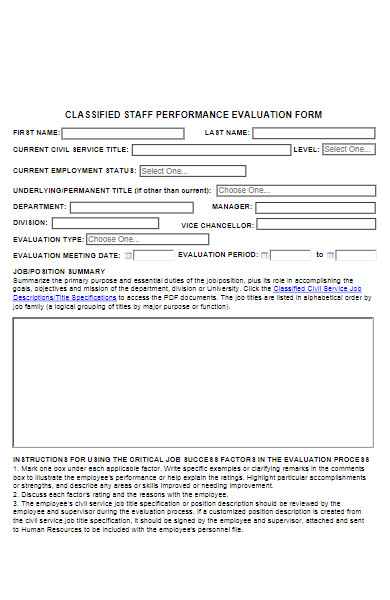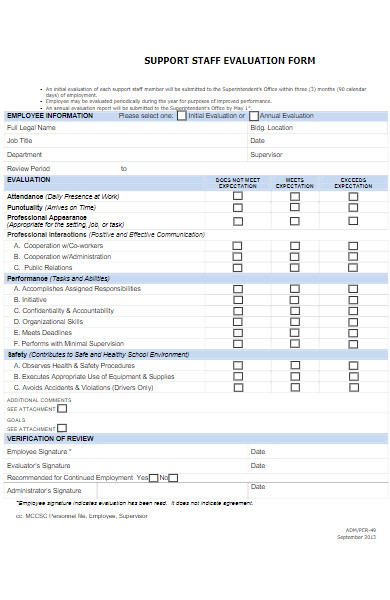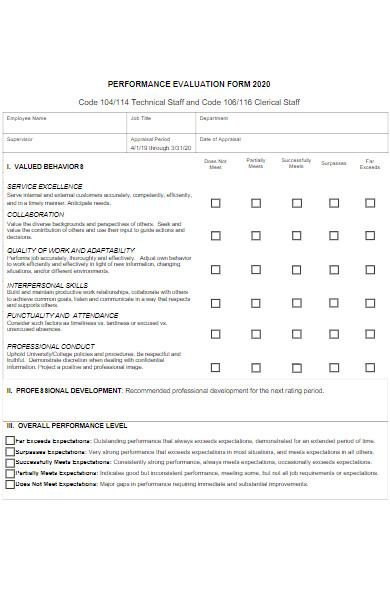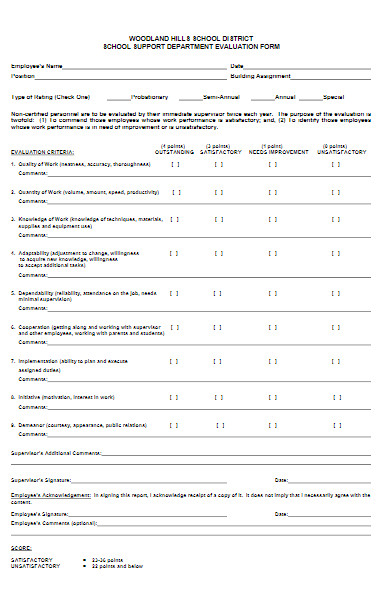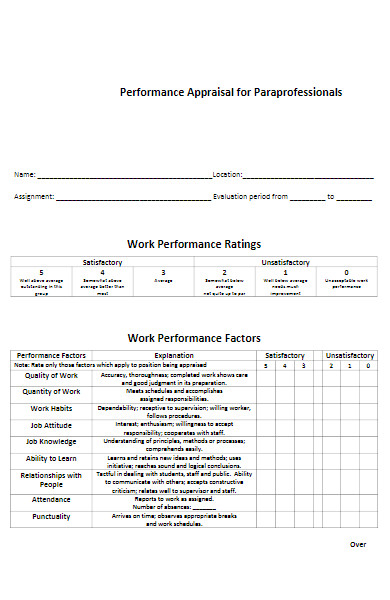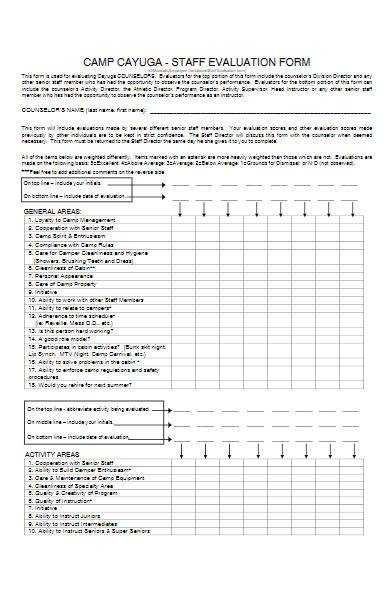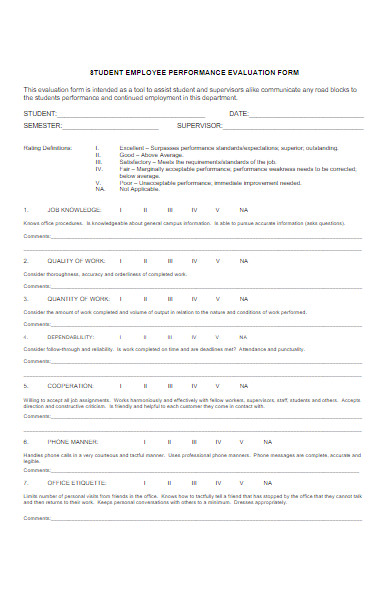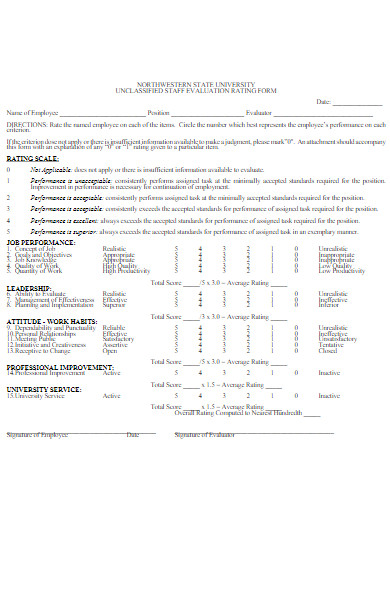Navigating the realm of employee performance can be intricate, and that’s where a Staff Evaluation Form comes into play. It stands as a structured tool designed to assess and improve workforce efficiency. Delving deep into its essence, from its profound meaning, diverse types, practical examples, to the meticulous steps of creation, one realizes its paramount importance. Beyond mere paperwork, a well-crafted form can serve as a catalyst for workplace growth, evolution, and excellence.
What is a Staff Evaluation Form ? – Definition
A Staff Evaluation Form is a standardized document used by organizations to systematically assess, document, and review an employee’s performance, behavior, and contributions over a specific period. It provides a formalized structure to capture feedback, set expectations, identify areas of improvement, and recognize achievements, ensuring that employees understand their roles, responsibilities, and how they align with the organization’s objectives. These printable form is a vital tool for personal development, future goal setting, and decision-making related to promotions, compensations, and training.
What is the Meaning of a Staff Evaluation Form?
The meaning of a Staff Evaluation Form lies in its purpose to provide an objective platform for supervisors and managers to assess and rate an employee’s work performance and professional attributes. It serves as a communication tool, bridging the gap between management and staff, by offering insights into areas of excellence and those needing improvement. These fillable form not only reflects an individual’s achievements, productivity, and behavior but also plays a pivotal role in career growth, compensation decisions, and organizational development. Essentially, it encapsulates the value, potential, and impact of an employee within an organization.
What is the Best Sample Staff Evaluation Form?
The best sample Staff Evaluation Form is subjective and varies based on the specific needs and goals of an organization. However, a universally effective form typically encompasses various key elements that capture a comprehensive picture of an employee’s performance. Here’s a sample template that includes these elements:
Employee Information:
- Name: ____________________________
- Position: ____________________________
- Department: ____________________________
- Evaluation Period: From _____ to ______
- Evaluator’s Name: ____________________________
Performance Categories:
(For each category, rate the employee on a scale of 1-5, with 1 being unsatisfactory and 5 being exceptional.)
-
Job Knowledge:
- Demonstrates an understanding of their role and responsibilities.
- Score: _____
-
Quality of Work:
- Delivers accurate, thorough, and timely results.
- Score: _____
-
Productivity:
- Completes assignments within set timeframes.
- Score: _____
-
Communication Skills:
- Effectively communicates with colleagues, supervisors, and subordinates.
- Score: _____
-
Teamwork and Interpersonal Skills:
- Collaborates effectively with team members.
- Score: _____
-
Adaptability:
- Responds well to change and unfamiliar situations.
- Score: _____
-
Problem-solving:
- Identifies, analyzes, and resolves challenges efficiently.
- Score: _____
-
Initiative and Proactiveness:
- Takes independent actions and provides suggestions for improvements.
- Score: _____
-
Dependability:
- Consistent in attendance and punctuality.
- Score: _____
-
Professional Development:
- Seeks opportunities for personal growth and skill-building.
- Score: _____
Goals and Objectives (for the next evaluation period):
- Goal 1: ________________________________________________________________
- Goal 2: ________________________________________________________________
- …
Evaluator’s Comments: (Provide specific feedback, both positive and areas needing improvement)
Employee’s Comments: (Feedback, questions, or concerns from the employee about the evaluation)
Recommendations for Improvement (if any):
Signatures:
Evaluator: ____________________________ Date: ______
Employee: ____________________________ Date: ______
This form is just a sample. The best staff evaluation form for any organization would be one that’s tailored to its specific needs, industry, and culture. It’s also beneficial to incorporate feedback form from staff members when designing or revising an evaluation form to ensure its effectiveness and relevance.
FREE 13+ Staff Evaluation Forms
How do you create an effective Staff Evaluation Form?
Creating an effective Staff Evaluation Form involves several key steps to ensure a comprehensive and objective assessment of an employee’s performance. Here’s a guide to help you craft one
Creating an Effective Staff Evaluation Form
- Objective Setting: Begin by clearly understanding and defining the objectives of the evaluation. Knowing what you want to achieve – be it recognizing top performers, identifying training needs, or setting future goals will guide the entire process.
- Job-Specific Criteria: Ensure that the evaluation criteria are relevant to the job role. For instance, a software developer and a sales executive will have different performance metrics.
- Use a Mix of Quantitative and Qualitative Metrics: While quantitative metrics (like sales targets achieved) provide a measurable outcome, qualitative metrics (like teamwork or communication skills) give a holistic view of an employee’s performance.
- Include Self-Assessment: Allow employees to evaluate themselves. This provides insight into their self-awareness and can highlight any discrepancies between their perception and that of the manager.
- Feedback Section: Incorporate a space for feedback. Constructive feedback helps employees understand areas of improvement, while positive feedback boosts morale.
- Rating Scale: Choose a consistent rating scale, such as a 1-5 point scale, with clear definitions for each point. For instance, 1 could mean ‘Needs Improvement’ and 5 could signify ‘Exceeds Expectations’.
- Regular Updates: Revise the form periodically to keep it updated with organizational changes and evolving job roles.
- Pilot Testing: Before implementing the form across the organization, test it with a smaller group. Gather feedback and make necessary changes.
- Training: Ensure that the managers or evaluators are trained to fill out the form accurately and without bias.
- Open Communication: Encourage an open dialogue between the evaluator and the employee. The form should serve as a foundation for a discussion, not just a one-sided assessment.
By meticulously crafting the Staff Evaluation Form and using it as part of a comprehensive evaluation process, organizations can drive employee growth, ensure fair evaluations, and ultimately enhance overall productivity. You should also take a look at our employee Evaluation Forms.
What should be included in a Staff Evaluation Form?
A Staff Evaluation Form should be comprehensive, covering various aspects of an employee’s performance. Here’s a breakdown of essential components to include:
-
Employee Information:
- Full name
- Job title
- Department
- Evaluation period
- Name of the evaluator
-
Job-Specific Performance Metrics:
- Depending on the job role, specify critical tasks and assess how well they’ve been executed. For instance, for a salesperson, you might evaluate “Number of new clients acquired.”
-
General Performance Metrics:
- Productivity: Assess the quantity and quality of work produced.
- Accuracy: Measure the precision and correctness of the work.
- Punctuality: Evaluate adherence to timelines and deadlines.
-
Soft Skills Evaluation:
- Communication skills: How effectively does the employee convey information?
- Teamwork: Assess the ability to work harmoniously with colleagues.
- Problem-solving: Evaluate the aptitude to address and resolve issues.
- Adaptability: Measure resilience and flexibility in dynamic situations.
-
Goals and Objectives:
- Review the goals set for the evaluation period and assess the achievement level.
- Discuss any challenges faced and support needed.
-
Self-Assessment Section:
- Allow employees to rate their performance. This promotes self-awareness and might highlight perceptions differing from management.
-
Training and Development:
- Identify areas where the employee might benefit from additional training or professional development.
- Document any courses or workshops attended during the evaluation period.
-
Feedback Section:
- Constructive comments on areas of improvement.
- Positive feedback highlighting strengths and commendable performance.
-
Rating Scale:
- Define a clear rating system, e.g., a scale of 1 to 5, with explanations for each score.
-
Future Goals and Expectations:
- Set objectives for the next evaluation period.
- Discuss potential growth paths and career opportunities.
-
Overall Performance Summary:
- A summarization of the employee’s overall performance, considering all the aspects evaluated.
-
Reviewer’s Signature and Date:
- Authentication of the evaluation by the reviewer.
-
Employee’s Signature and Date:
- Indicates the employee’s acknowledgment of the evaluation. This doesn’t necessarily mean agreement, but it shows they’ve been informed.
Including these components in a Staff Evaluation Form ensures a thorough and holistic assessment of an employee’s performance, skills, and potential areas for growth. Our appraisal evaluation form is also worth a look at
How often should a Staff Evaluation Form be filled out?
The frequency with which a Staff Evaluation Form should be filled out varies depending on the organization’s goals, culture, and the nature of the job. However, there are common practices adopted by many businesses:
- Annual Evaluations: This is a traditional approach where employees are assessed once a year, typically at the end of the fiscal or calendar year. This allows for a comprehensive review of the employee’s yearly performance, accomplishments, and areas for improvement.
- Semi-Annual (Biannual) Evaluations: Conducted twice a year, this approach allows for more frequent feedback. It can be particularly useful for rapidly growing companies or those with rapidly changing roles, giving employees the chance to recalibrate and align with organizational goals more regularly.
- Quarterly Evaluations: Some organizations prefer quarterly reviews, especially those following agile methodologies or with fast-paced environments. This frequent check-in ensures that both employees and managers are consistently aligned with company objectives.
- Monthly Evaluations: Monthly reviews can be beneficial for roles that have short-term, clear-cut goals. They can also be useful for new employees in their probationary period to ensure a smooth onboarding process.
- Project-Based Evaluations: In certain job roles, especially those related to project management, evaluations might occur at the end of a significant project. This approach allows for timely feedback relevant to specific tasks and roles within the project.
- Continuous Feedback Model: Some modern workplaces are moving towards a model where formalized performance reviews are less frequent, but continuous feedback is encouraged. Managers provide real-time feedback, and formal documentation might only happen annually or semi-annually.
- Event-Triggered Evaluations: These are unscheduled evaluations triggered by specific events such as a role change, a significant achievement, or performance issues.
While the frequency can vary, it’s essential that evaluations, regardless of how often they occur, are consistent, fair, and constructive. Regular feedback can motivate employees, help them align better with organizational goals, and identify areas for professional development. Organizations should choose a frequency that aligns with their operational needs and fosters a culture of continuous improvement and open communication. In addition, you should review our Sample Evaluation Forms.
Where can I find templates for a Staff Evaluation Form?
Finding templates for a Staff Evaluation Form can be incredibly helpful, as it saves time and ensures that you’re covering all the necessary evaluation areas. Here are some places where you can find these templates:
- Online Template Platforms: Websites like Template.net, Smartsheet, and JotForm have various evaluation templates suitable for different business contexts.
- Human Resources Software: Many HR software platforms, such as BambooHR, Workday, and Zenefits, come with built-in staff evaluation tools or templates. If your organization already uses such software, it’s worth checking out.
- Document Platforms: Websites like Microsoft Office’s template gallery or Google Workspace Marketplace offer free templates for documents, including staff evaluation forms.
- Professional Organizations: If you belong to a professional HR organization, such as the Society for Human Resource Management (SHRM), they often provide resources, including templates, for members.
- Purchase from Vendors: There are companies and consultancies that specialize in HR resources, and they often sell more detailed or industry-specific evaluation templates.
- Custom Creation: If you can’t find a template that suits your needs, you might consider creating your own. This allows you to tailor the form precisely to your organization’s needs, culture, and evaluation criteria. You can always consult with an HR professional or use existing templates as inspiration.
- Online Communities: Websites like Reddit, Quora, or industry-specific forums might have users who have shared templates or can guide you to resources they’ve found helpful.
- University Websites: Some universities with robust business or HR programs offer free resources, including staff evaluation templates.
Before using any template, it’s essential to review and customize it to fit the specific needs and culture of your organization. Ensure that it complies with any relevant regulations and that it aligns with your company’s values and goals. You may also be interested in our Performance Review Forms.
How do you analyze results from a Staff Evaluation Form?
Analyzing results from a Staff Evaluation Form requires a systematic approach to ensure that the insights drawn are objective, actionable, and aligned with organizational goals. Here’s a step-by-step guide to help you navigate this process:
-
Centralize Data Collection:
- Before you analyze, ensure all completed evaluation forms are gathered in one place, whether that’s a physical folder, digital folder, or a software system.
-
Quantitative Analysis:
- If the form has scaled questions (e.g., rating from 1 to 5), calculate average scores for each question or section.
- Compare individual scores against departmental or organizational averages to identify outliers.
- Track changes over time. If this isn’t the first evaluation, compare scores with previous evaluations to note any trends.
-
Qualitative Analysis:
- Review open-ended responses or comments. While these can’t be ‘averaged’, patterns may emerge in the feedback.
- Categorize comments. For instance, you might have categories like “communication,” “technical skills,” or “teamwork.”
- Note any recurring themes, both positive and negative.
-
Identify Strengths and Areas for Improvement:
- For areas where scores are consistently high, identify what’s working well and how those strengths can be maintained or replicated.
- For lower-scoring areas, determine the underlying issues and potential solutions or training opportunities.
-
Compare Peer and Manager Evaluations:
- If the staff evaluation included both peer reviews and manager reviews, compare the feedback. Consistencies can validate specific points, while discrepancies can highlight areas that may require further investigation.
-
Set Actionable Goals:
- Based on the insights from the evaluation, set clear and achievable goals for staff members.
- For areas that need improvement, consider creating a development plan. This might include training, mentorship, or other resources.
-
Engage in Discussions:
- Arrange one-on-one discussions with staff members to go over their evaluations. This is an opportunity to provide feedback, clarify any points on the form, and discuss the way forward.
- Ensure these conversations are constructive, focusing on growth and development.
-
Review the Evaluation Form Itself:
- After analyzing the results, reflect on the effectiveness of the evaluation form. Are there questions that were consistently misunderstood? Were there areas of performance not covered by the form that should be?
-
Document Insights:
- Compile your findings into a report or presentation. This can be shared with higher management or used for internal team reviews.
-
Continuous Improvement:
- Use the insights from the analysis to refine processes, offer targeted training, or even adjust the roles and responsibilities of staff members to better align with their strengths.
Remember, the goal of the Staff Evaluation Form is not just assessment but improvement. The analysis should lead to actionable insights that help both the staff members and the organization grow and develop. You may also be interested to browse through our other Performance Evaluation Forms.
Why is setting goals important in a Staff Evaluation Form?
Setting goals in a Staff Evaluation Form is fundamental for several pivotal reasons:
- Direction and Purpose: Clear goals provide employees with a roadmap, pointing them towards what is expected of them and what they should strive to achieve by the next evaluation period.
- Motivation: Recognizing and understanding what needs to be accomplished can boost motivation. Achieving set targets can also instill a sense of accomplishment and pride in employees.
- Performance Measurement: Goals offer a tangible benchmark against which employee performance can be measured. It helps managers and employees gauge progress over a specified period.
- Clarity and Focus: Clearly articulated goals ensure that employees prioritize their tasks and energy on what matters most, reducing wasted effort on non-essential activities.
- Skill Development: By setting specific goals, employees can identify the skills and resources they need to achieve them. This can lead to targeted training, upskilling, and personal development.
- Accountability: Goals create a sense of responsibility. Both the evaluator and the employee become accountable for achieving set targets. If goals are not met, it provides an opportunity to discuss challenges faced and ways to overcome them in the future.
- Feedback Mechanism: With set goals, feedback becomes constructive and specific. Rather than vague comments, managers can provide feedback directly related to goal achievement, discussing what went well and areas of improvement.
- Informed Decision Making: Goal-based evaluations provide data-driven insights that can guide decisions related to promotions, pay raises, training needs, or even role changes.
- Enhanced Communication: When goals are set and discussed, it fosters open communication between managers and their teams. It ensures everyone is aligned and has a shared understanding of expectations.
- Continuous Improvement: Regularly setting and evaluating goals promotes a culture of continuous improvement. It encourages employees to consistently push their boundaries and seek better ways of doing things.
- Organizational Alignment: Individual goals can be aligned with departmental and organizational objectives. This ensures that everyone is working cohesively towards the broader objectives of the organization.
In essence, setting goals in a Staff Evaluation Form is not just about measuring performance. It’s about driving growth, fostering a sense of purpose, and ensuring both individual and organizational success. You should also take a look at our Job Performance Evaluation Forms.
How to Create a Staff Evaluation Form?
Creating a Staff Evaluation Form involves careful consideration to ensure that the assessment is comprehensive, relevant, and beneficial for both the organization and the employee. Here’s a step-by-step guide:
1. Define the Purpose:
- Understand why you’re creating the form. Is it for annual reviews, probationary periods, or performance improvements?
- Clearly define what you want to achieve with the evaluation.
2. Research & Gather Input:
- Look at other evaluation forms for inspiration.
- Involve HR and possibly some representatives from management and staff to get diverse input.
3. Decide on the Evaluation Criteria:
- These could include job knowledge, quality of work, productivity, communication skills, teamwork, initiative, punctuality, etc.
- Align criteria with job descriptions and organizational goals.
4. Choose a Rating Scale:
- Decide on a scale that is easy to understand (e.g., 1-5, where 1 is ‘Poor’ and 5 is ‘Excellent’).
5. Design the Form:
- Start with basic information: employee name, department, position, date, evaluator name, etc.
- List down all the evaluation criteria.
- Leave space for ratings and comments next to each criterion.
- Include a section for overall comments, feedback, and recommendations.
6. Set Goals:
- Add a section where the evaluator and the employee can set specific goals for the next period. This encourages growth and development.
7. Seek Feedback on the Draft:
- Before finalizing, share the draft form with a few managers or team members to gather feedback. Make adjustments if necessary.
8. Pilot the Form:
- Initially, use the form with a small group to see if it captures all the necessary information and if any sections are confusing.
- Make any adjustments based on the feedback from the pilot phase.
9. Train Evaluators:
- Ensure that managers or those who will be conducting the evaluations understand how to use the form and what each criterion means.
- Emphasize the importance of providing constructive feedback.
10. Implement & Regularly Update:
- Start using the form organization-wide.
- Periodically review and update the form to ensure its continued relevance.
11. Digitalize if Possible:
- Consider using digital tools or platforms where evaluations can be done online. This can streamline the process and make data storage and analysis more efficient.
12. Ensure Confidentiality:
- Make it clear that the feedback will remain confidential and will be used solely for performance improvement.
Remember, the goal of a Staff Evaluation Form is not just to assess but to foster growth, provide clarity, and ensure both the employee and the organization can achieve their objectives. Proper creation and implementation can make this tool invaluable.
Tips for creating an Effective Staff Evaluation Form
Absolutely, an effective Staff Evaluation Form is crucial for both organizations and employees to gauge performance and foster professional growth. Here are some tips to ensure that your form is both comprehensive and beneficial:
- Start with Clear Objectives:
- Know what you want to achieve with the evaluation. This could range from gauging overall performance to identifying areas for improvement or training.
- Keep it Simple and Direct:
- Overly complex forms can be daunting and can lead to inconsistent responses. Use clear language and avoid jargon.
- Use a Consistent Rating System:
- Whether it’s numerical, descriptive, or a combination, ensure that it’s easy to understand and apply.
- Include Open-Ended Questions:
- This gives employees the opportunity to express their opinions or provide context to their answers.
- Avoid Leading or Biased Questions:
- Ensure that questions are neutral and don’t lead respondents to a particular answer.
- Make it Comprehensive but Not Excessive:
- Ensure all relevant areas of performance are covered but avoid making the form too lengthy which can reduce its effectiveness.
- Incorporate Goal Setting:
- A section where both managers and employees can set and align future goals is essential for continued growth.
- Provide Space for Feedback:
- Feedback isn’t a one-way street. Allow space for employees to comment or provide feedback on their team, management, or overall company culture.
- Ensure Anonymity if Possible:
- If peers are evaluating each other, ensure that the responses are anonymous to promote honesty.
- Regularly Update the Form:
- As roles evolve and company objectives shift, your evaluation form should reflect these changes. Regular updates ensure it remains relevant.
- Pilot Before Full Implementation:
- Test the form with a small group first to gather feedback and refine as necessary.
- Train the Evaluators:
- It’s essential that managers or evaluators understand how to use the form correctly and consistently.
- Focus on Constructive Feedback:
- Encourage evaluators to provide feedback that can help employees grow, rather than just pointing out flaws.
- Digitalize the Process:
- Consider using online platforms for evaluations. They’re often more efficient, environmentally friendly, and can offer analytics.
- Review Results with Employees:
- It’s crucial for employees to understand their evaluations. Organize feedback sessions where they can discuss results with their supervisors.
- Encourage Two-Way Communication:
- The evaluation process should be a dialogue. Allow employees to express concerns, seek clarity, or discuss future growth opportunities.
Remember, the aim of a Staff Evaluation Form is not merely to critique but to pave a way for development, recognize achievements, and align goals with organizational objectives.
A Staff Evaluation Form is a pivotal tool for organizations, providing insight into employee performance and areas for growth. With varied types tailored to specific needs, these forms serve as both reflective and forward-planning instruments. By understanding their meaning, employing the right type, and following a structured creation guide, companies can optimize performance and align individual goals with organizational objectives. In addition, you should review our Employee Evaluation Forms.
Related Posts Here
-
Employee Performance Evaluation Form
-
Sensory Evaluation Form
-
Employee Pay Increase Form
-
Mentee Evaluation Form
-
Mentor Evaluation Form
-
Course Evaluation Form
-
FREE 8+ Job Performance Evaluation Forms & Samples in PDF | MS Word
-
FREE 7+ Oral Presentation Evaluation Forms in PDF | MS Word
-
Food Evaluation Form
-
Internship Evaluation Form
-
Debate Evaluation Form
-
Nurse Evaluation Form
-
Contractor Evaluation Form
-
Speech Evaluation Form
-
FREE 9+ Sample Class Evaluation Forms in PDF | MS Word | Excel
